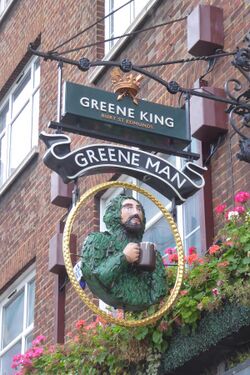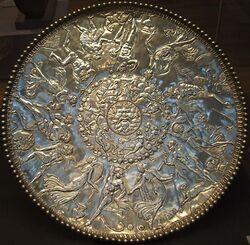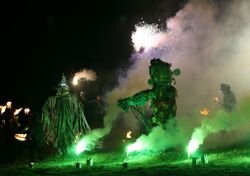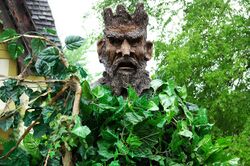Green Man (folklore)
Topic: Unsolved
 From HandWiki - Reading time: 7 min
From HandWiki - Reading time: 7 min
The Green Man is a term with a variety of connotations in folklore and related fields.
During the early modern period in England, and sometimes elsewhere, the figure of a man dressed in a foliage costume, and usually carrying a club, was a variant of the broader European motif of the Wild Man (also known as wild man of the woods, or woodwose). By at least the 16th century the term "green man" was used in England for a man who was covered in leaves as part of a pageant, parade or ritual, who often was the whiffler (a person who clears a path or space through the crowd for a parade or performance). From the 17th century such figures were used for the names of pubs, and painted on their signs.[1]
In 1939, Julia Somerset, Lady Raglan, wrote an article in the journal Folklore that connected the foliate head artistic motif of medieval church architecture (which she also called the "Green Man") with other "green"-related concepts, such as the "Green Man" pubs, the Jack in the Green folk custom and May Day celebrations.[2] She proposed that the "Green Man" represented a pagan fertility figure. The idea has been contested by other folklorists, who assert that Lady Raglan had no evidence that the foliate head motif or other concepts she associated with it were pagan in nature.[3][4]
Lady Raglan's idea of the "Green Man" was adopted from the 1960s onward by the New Age and Neopagan movements,[3][4] and some authors have considered it to represent a Jungian archetype.[5] The nature of the Green Man as a mythological figure has been described as "20th-century folklore".[4]
Popular, modern culture
Literature
The Green Man has been asserted by some authors to be a recurring theme in literature. Leo Brady, in his book, Haunted: On Ghosts, Witches, Vampires, Zombies, and Other Monsters of the Natural and Supernatural Worlds asserts that the figures of Robin Hood and Peter Pan are associated with a Green Man, as is that of the Green Knight in Sir Gawain and the Green Knight. The Green Knight in this poem serves as both a monster antagonist and as mentor to Sir Gawain, belonging to a pre-Christian world which seems antagonistic to, but is in the end harmonious with, the Christian one.[6] In Thomas Nashe's masque Summer's Last Will and Testament (1592, printed 1600), the character commenting upon the action remarks, after the exit of "Satyrs and wood-Nymphs", "The rest of the green men have reasonable voices […]".
During the post-war era literary scholars interpreted the Green Knight as being a literary representation of Lady Raglan's Green Man as described in her article "The Green Man in Church Architecture", published in Folklore journal of March 1939. This association ultimately helped consolidate the belief that the Green Man was a genuine, Medieval folkloric, figure.[7] Raglan's idea that the Green Man is a mythological figure has been described as "bunk", with other folklorists arguing that it is simply an architectural motif.[3]
In the final years of the 20th century and earliest of the 21st, the appearance of the Green Man proliferated in children's literature.[8] Examples of such novels in which the Green Man is a central character are Bel Mooney's 1997 works The Green Man and Joining the Rainbow, Jane Gardam's 1998 The Green Man, and Geraldine McCaughrean's 1998 The Stones are Hatching.[8] Within many of these depictions, the Green Man figure absorbs and supplants a variety of other wild men and gods, in particular those which are associated with a seasonal death and rebirth.[8] The Rotherweird Trilogy by Andrew Caldecott draws heavily on the concept of the Green Man, embodied by the gardener Hayman Salt who is transformed into the Green Man at the climax of the first book.
The Green Man is an integral character in Max Porter's novel Lanny, which was longlisted for the 2019 Booker Prize. The Green Men (including a suffragist irritated by the name) and their powers figure significantly in K. J. Charles's novel The Spectred Isle (2017), which was nominated for a RITA Award.[9]
The character Uncle Mike in the Mercy Thompson series by Patricia Briggs is referred to as Green Man by the Welsh character Samuel Cornick in book 3.
Sculpture
The Green Man image made a resurgence in modern times, with artists from around the world interweaving the imagery into various modes of work.[10] English artist Paul Sivell created the Whitefield Green Man, a wood carving in a dead section of a living oak tree; David Eveleigh, an English garden designer created the Penpont Green Man Millennium Maze, in Powys, Wales ( as of 2006 the largest depiction of a Green Man image in the world); Zambian sculptor Toin Adams created the 12m-tall Green Man in Birmingham, UK as of 2006 the largest free-standing sculpture of the Green Man in the world; and sculptor M. J. Anderson created the marble sculpture titled Green Man as Original Coastal Aboriginal Man of All Time from Whence the Bush and All of Nature Sprouts from his Fingers. Others include Jane Brideson, Australian artist Marjorie Bussey, American artist Monica Richards, and English fantasy artist Peter Pracownik, whose artwork has appeared in several media, including full-body tattoos.[10]
American artist Rob Juszak took the theme of the Green Man as Earth's spiritual protector and turned it into a vision of the Green Man cradling the planet; Dorothy Bowen created a kimono silk painting, titled Greenwoman, as an expression of the feminine aspect of the legend.[10]
Banksia Man by Australian artist Graham Wilson; his reinterpretations incorporate native Australian flora.
The Green Man by sculptor Toin Adams at the Custard Factory, Birmingham, England[11]
A Green Man with the body of a faun: Green Mason by Australian artist Graham Wilson (21st century)
Film
An interpretation of the Green Man and related folklore such as the Sheela na gig inspired characters and motifs in Alex Garland's 2022 film Men.
Modern paganism
For many modern pagans, the Green Man is used as a symbol of seasonal renewal and ecological awareness.[12] In Wicca, the Green Man has often been used as a representation of the Horned God, a syncretic deity that incorporates aspects of, among others, the Celtic Cernunnos and the Greek Pan.[13]
Gallery
Green Man painted on 1867 neoclassical ceiling, Bankfield Museum, Halifax, UK
Architectural detail, Portland, Oregon (late 19th or early 20th century?)
See also
- Apple Tree Man
- Blodeuwedd
- Burryman
- Clun Green Man Festival
- Ent
- Flower Pot Men
- Gargoyle
- Green Giant
- The Green Man of Knowledge
- Grotesque
- Holly King and Oak King
- Hunky punk
- Jack in the Green
- Krampus
- List of nature deities
- Sheela na Gig
- Three hares
- Wild Man
Citations
- ↑ Winick, Stephen (2021-02-17). "What Was the Green Man? | Folklife Today". https://blogs.loc.gov/folklife/2021/02/what-was-the-green-man/.
- ↑ Centerwall, Brandon S. (January 1997). "The Name of the Green Man" (in en). Folklore 108 (1–2): 25–33. doi:10.1080/0015587X.1997.9715933. ISSN 0015-587X. http://www.tandfonline.com/doi/abs/10.1080/0015587X.1997.9715933.
- ↑ 3.0 3.1 3.2 Livingstone, Josephine (2016-03-07). "The Remarkable Persistence of the Green Man" (in en-US). The New Yorker. https://www.newyorker.com/books/page-turner/the-remarkable-persistence-of-the-green-man. Retrieved 2023-05-07.
- ↑ 4.0 4.1 4.2 Olmstead, Molly (2023-04-08). "Is the Green Man British Enough for the Royal Coronation?" (in en-US). Slate. ISSN 1091-2339. https://slate.com/news-and-politics/2023/04/green-man-king-charles-coronation-invitation.html.
- ↑ Araneo, Phyllis. 2008. The Archetypal, Twenty First Century Resurrection of the Ancient Image of the Green Man. Journal of Futures Studies 13 (1): 43–64.
- ↑ Braudy, Leo (Oct 25, 2016). Haunted: On Ghosts, Witches, Vampires, Zombies, and Other Monsters of the Natural and Supernatural Worlds. Yale University Press. p. 277. ISBN 978-0300224726. https://books.google.com/books?id=CqAqDQAAQBAJ. Retrieved 28 September 2017.
- ↑ Larrington, Carolyne (2015). The Land of the Green Man: A Journey Through the Supernatural Landscapes of the British Isles. I.B.Tauris. p. 227. ISBN 978-1780769912. https://books.google.com/books?id=5E4FCwAAQBAJ.
- ↑ 8.0 8.1 8.2 Bramwell 2009, p. 59.
- ↑ Charles, K. J. (2017). The Spectred Isle. KJC Books. ISBN 9780995799073. https://kjcharleswriter.com/green-men-world/.
- ↑ 10.0 10.1 10.2 Araneo, Phyllis (2006). Green Man Resurrected: An Examination of the Underlying Meanings and Messages of the Re-Emergence of the Ancient Image of the Green Man in Contemporary, Western, Visual Culture (MCA thesis). Queensland, Australia.: University of the Sunshine Coast. doi:10.4227/39/596566fcfaf95.
- ↑ The Birmingham Post, June 2002
- ↑ Bramwell 2009, p. 53.
- ↑ Varner, Gary R. (2006). The Mythic Forest, the Green Man and the Spirit of Nature. New York: Algora. p. 103. ISBN 9780875864358.
Sources cited
- Basford, Kathleen (1998). The Green Man. Cambridge: D. S. Brewer. ISBN 978-0859914970.
- Bramwell, Peter (2009). Pagan Themes in Modern Children's Fiction: Green Man, Shamanism, Earth Mysteries. New York: Palgrave Macmillan. ISBN 978-0-230-21839-0.
 |
 KSF
KSF





















